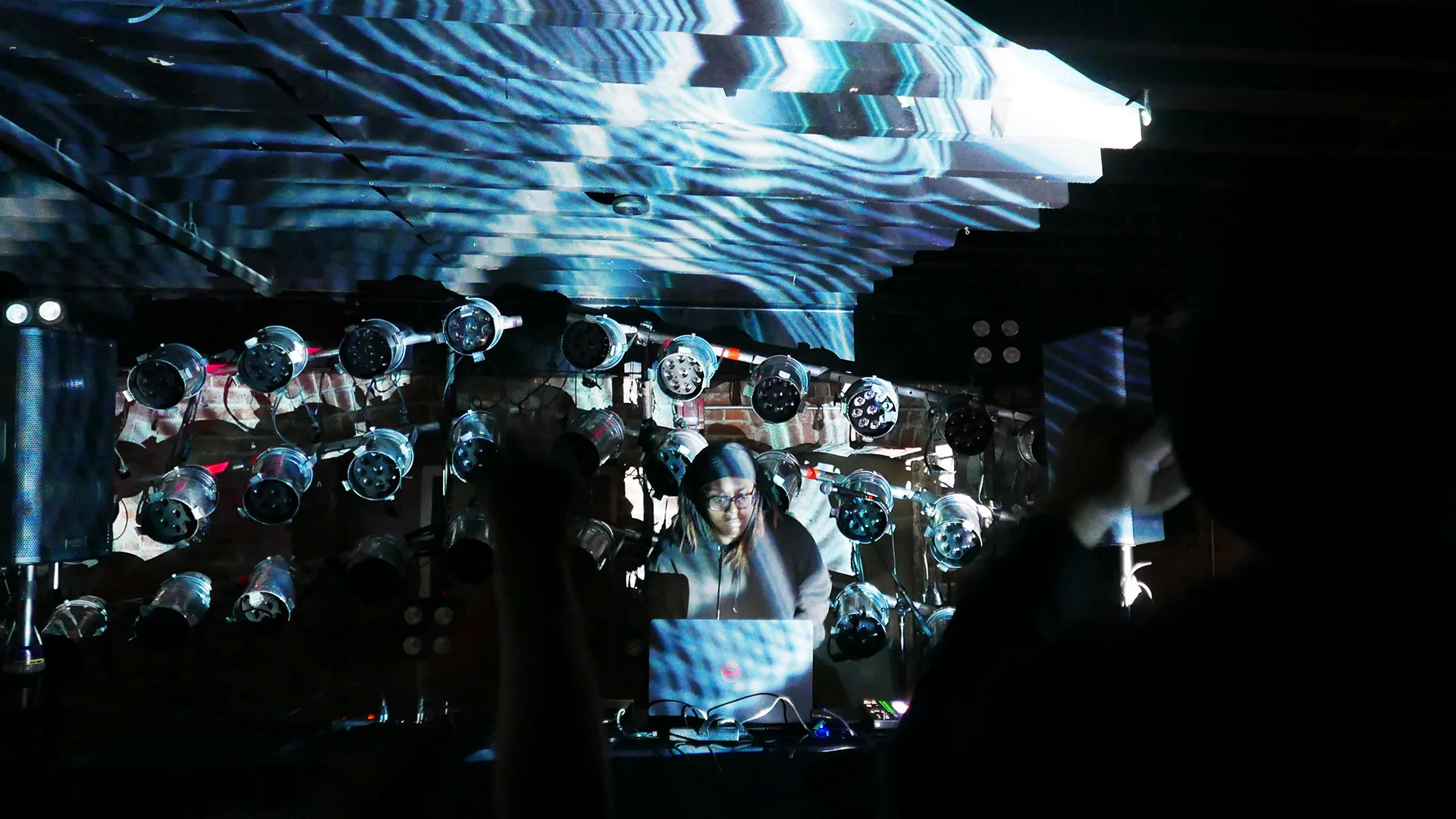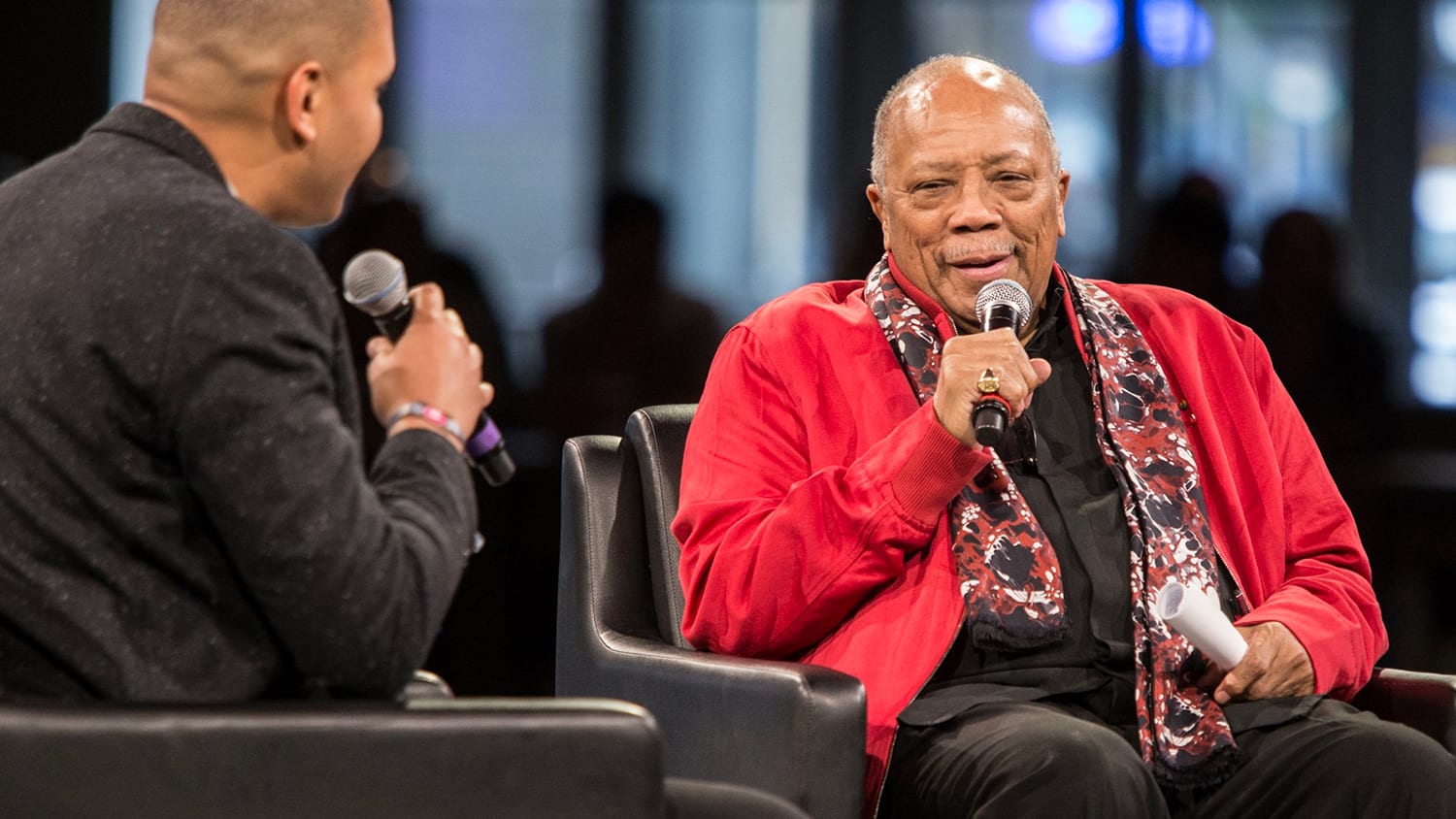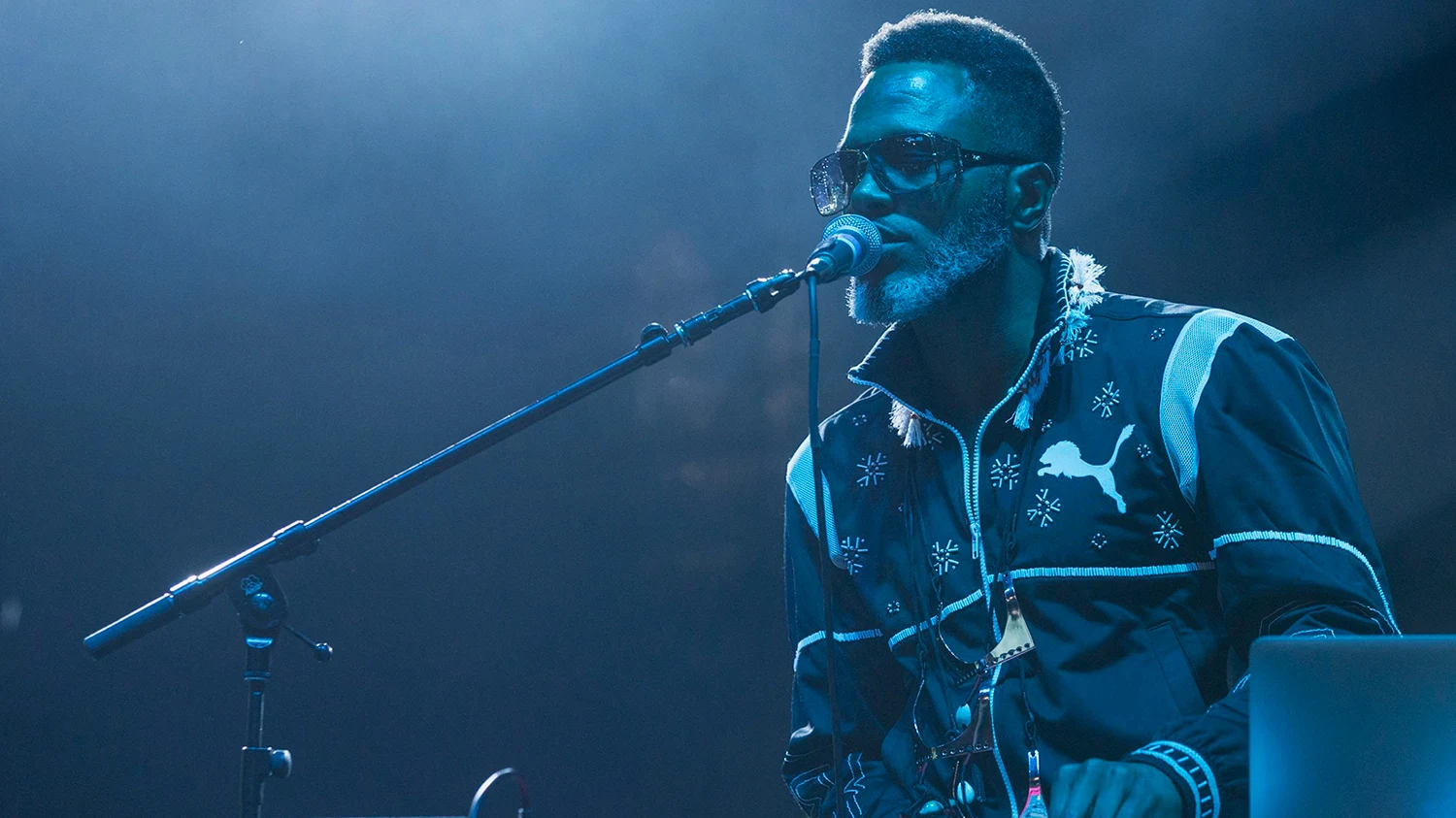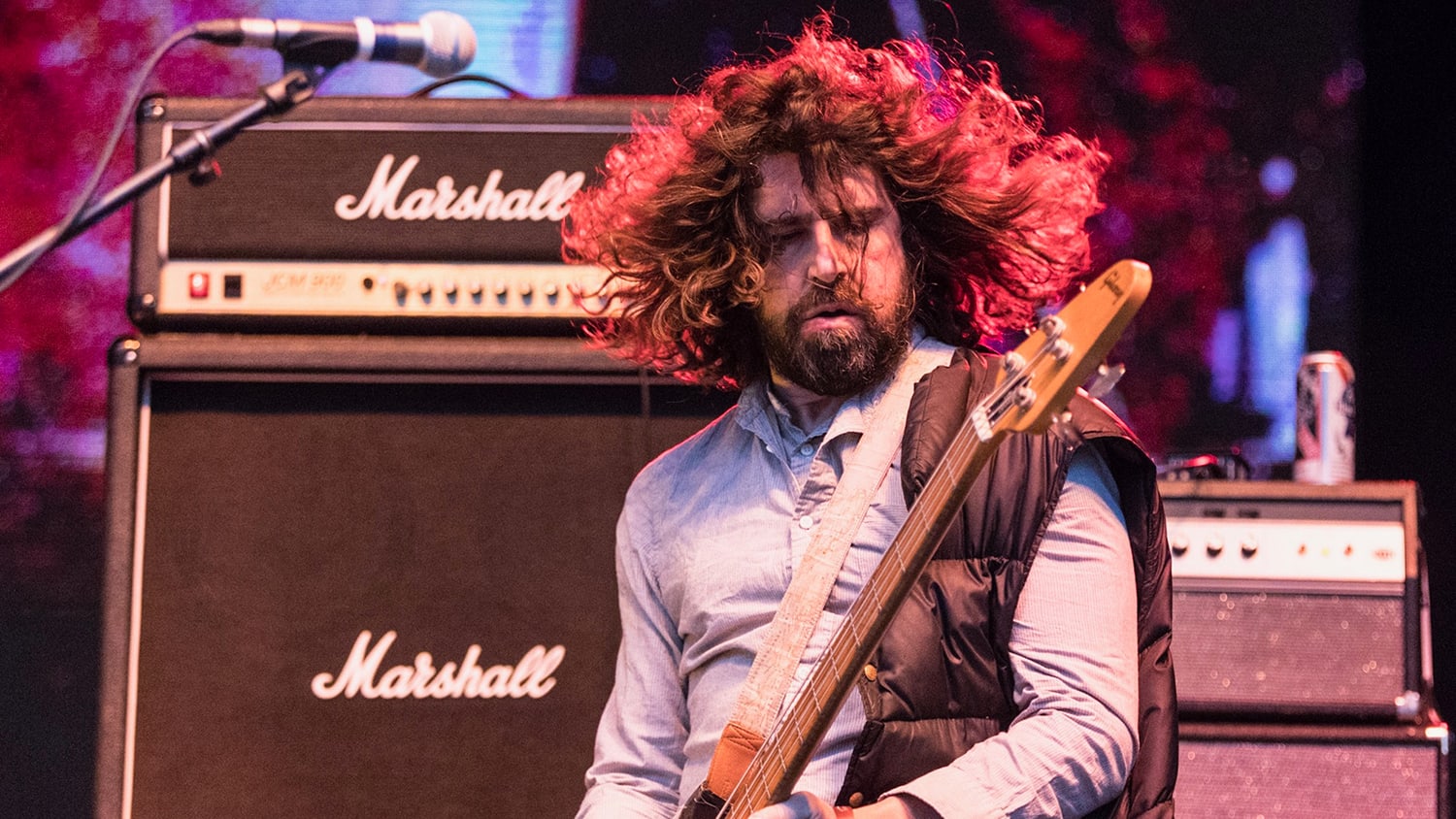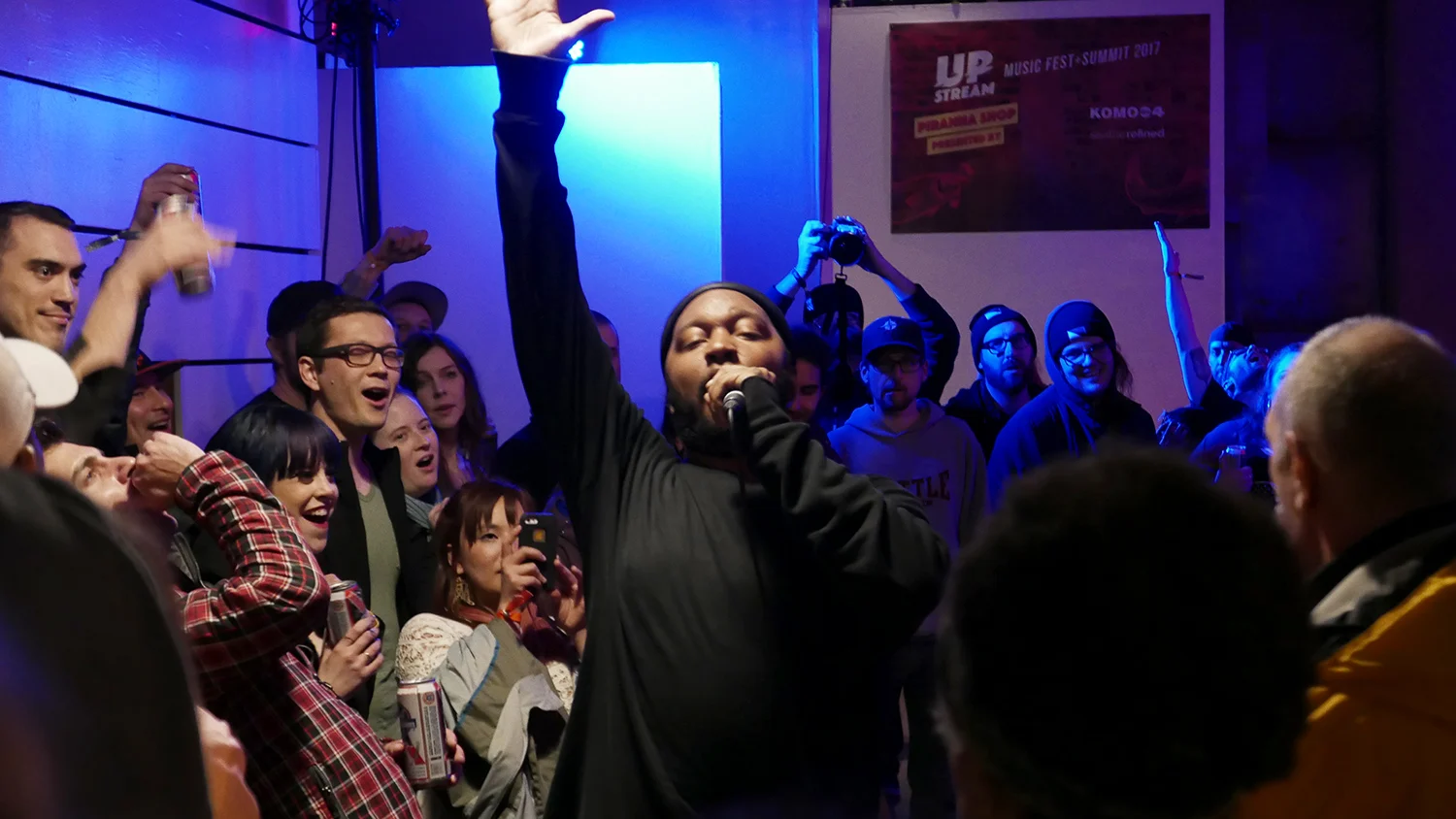On a typically drizzly Seattle night this past May, a crowd shuffled through metal detectors to pack the plaza outside CenturyLink Field, the downtown stadium where the Seahawks play football. Beneath a small white party tent sat Paul Allen—music nerd, lead guitarist of blues-based rockers The Underthinkers, philanthropic Renaissance Man, and a Microsoft cofounder. It’s not unusual to see him at the stadium during football games (he owns the team, along with the Portland Trailblazers), but tonight he was there to watch the first headline show at the inaugural Upstream Music Festival and Summit, which he also founded.
As a cloud of vape vapor descended over the audience, Allen and his companion reclined in lounge chairs and the producer DJ and MC Flying Lotus took the stage. Ellison (real name Steven Ellison) often performs in a special contraption: a traditional DJ booth surrounded by projection screens, placing him inside a 3D world of cartoon characters, floating text, jellyfish, viruses, and high-speed Escher-like recursive patterns. It’s hypnotic, intoxicating, eye-popping, possibly seizure-inducing, simultaneously retro and futuristic. Imagine watching a Win 95 screensaver through a giant Hololens, on acid.
A few minutes into his set, the beats went quiet, the plaintive synths of the Twin Peaks theme drifted in, and a new trap-style rhythm emerged. It was a deft nod to the locale—the real town of Twin Peaks is a thirty-minute drive away—and the crowd was his. Amid the smoke and fog, Angelo Badalamenti’s spooky tune, fast-forwarded through Flying Lotus’s electronica, felt like an appropriate motif for the festival, and its lofty goal: to foster the city’s local music scene—even as musicians’ rents rise faster than the DJ’s pulsating lights.
It’s a dissonant, stomach-rattling, though not necessarily unpleasant, theme, reflecting the inherent conflict between the influx of Seattle’s growing Big Tech gentrifiers—including Amazon and Microsoft—and the scrappy artists who increasingly struggle to call Seattle home. Allen’s festival rests on a seeming contradiction, sponsored as it is by the same tech money that’s fueling growth and rising living costs in Seattle. It’s not a new tension. His investment company Vulcan Inc. is known locally for its massive real estate holdings, but it also invests in a wide range of projects throughout the Pacific Northwest that exemplify his scientific, social, environmental, and cultural priorities. Aside from space, AI, and energy, a Vulcan pamphlet notes, a “thriving arts and culture scene are essential for strong and diverse communities.”
But Seattle’s rapid and shiny buildup (it’s the national capital of construction cranes, and has a faster-growing population than any big American city) hasn’t been easy on its legendary music communities. As its homeless population lags behind only New York and Los Angeles, record-breaking housing prices—growing at the fastest rate in the country and driven by a persistent wave of wealthy new tech workers—threaten not only reasonable rents but the house shows and DIY spaces that are the lifeblood of the city’s music scene. Increasingly, these spaces are fading out or getting pushed to the suburbs, a geographic shift that is fragmenting Seattle’s strong, neighborhood-based creative communities.
“The artist/musician class in Seattle—the one that Vulcan intends to support and invest in—is being economically displaced at a growing pace,” read a local petition posted to Change.org a month before the festival. The petitioners called on Allen “to set an exciting new precedent for equitable development” by funding more affordable housing, artist studios, and rehearsal spaces, with a particular focus on the historically black Central District, where Vulcan is starting two major housing and retail redevelopment projects on a $53 million, 10-acre parcel.
“We have reached out and are hoping to meet with the artists behind the letter,” said a Vulcan spokesperson. “This conversation requires many stakeholders, including developers.” Allen, who would not comment for this story, made a $30 million pledge in April toward a permanent housing facility for as many as 100 low-income and homeless families—one of a number of similar recent commitments by him and other corporate titans.
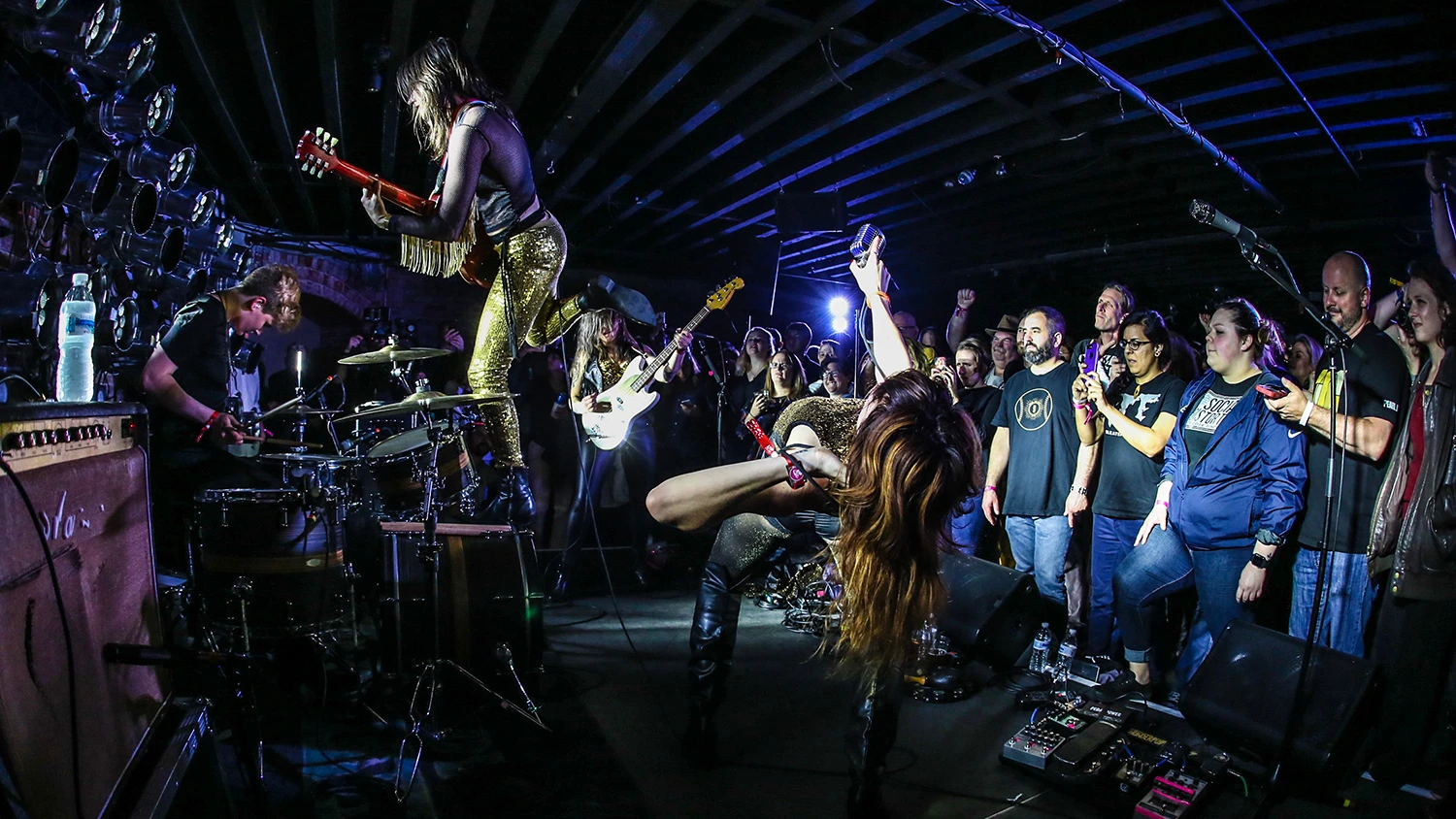
So why launch another festival? Ask Jeff Vetting, Upstream’s genial executive director and a veteran of local radio powerhouse KEXP, and he’ll talk about the importance of shining a light on emerging Pacific Northwest artists. Indeed, a majority of the first Upstream’s 300-plus artists—booked by curator Melissa Darby with input from a committee of 46 local music gurus and 46 guest curators—were local.
Related: The Anti-Fyre Festival
Darby’s and Vetting’s efforts paid off. During the inaugural Upstream festival, a parade of bands in a slew of bars in nearby Pioneer Square created an urban playlist you could walk through without ever repeating genres. On Saturday night alone, I traipsed from a mind-bending performance by local avant-garde hip-hop heroes Shabazz Palaces to the K Records crooner Karl Blau to the ethereal experimentalism of NAAVI, from the embellishments of Seattle funk 8-piece The Polyrhythmics to an underground comedy club bouncing with the furious and baroque percussive footwork of Jlin.
The audiences appeared to be happy, friendly, and refreshingly diverse in age. Musicians reported being satisfied with their fees. Some attendees grumbled about the admission price ($60 per day) and others were thankful the organizers had kept the corporate logos to a minimum, recruiting as major sponsors only two companies—Amazon Music and Amazon Web Services.
Even the app was interesting. You could not only look at a map and a schedule but also listen to nearly every band’s music, check capacity at venues, connect with other festivalgoers through “Braindates” and even—brilliantly—tip needy artists.
Signal Boosting
Like South by Soutwest, its distant relative in Austin, Upstream isn’t just about seeing shows but bolstering the region’s music economy—think of what places like New York, Nashville, and Los Angeles mean to the music business, but with a tech twist. During the festival’s two days, an event space at the stadium hosted Seattle-linked keynote speakers—Macklemore, Quincy Jones, Kill Rock Stars president Portia Sabin, film composer Ron Jones, Mike McCready of Pearl Jam—while a slew of panels featured entrepreneurs, technologists, and musicians talking about everything from data analytics to video game composition. Part of the aim was to underscore existing untapped networking opportunities for Seattle’s artists and techies. “Hopefully we can start creating those relationships and really start building our music economy,” says Vetting.
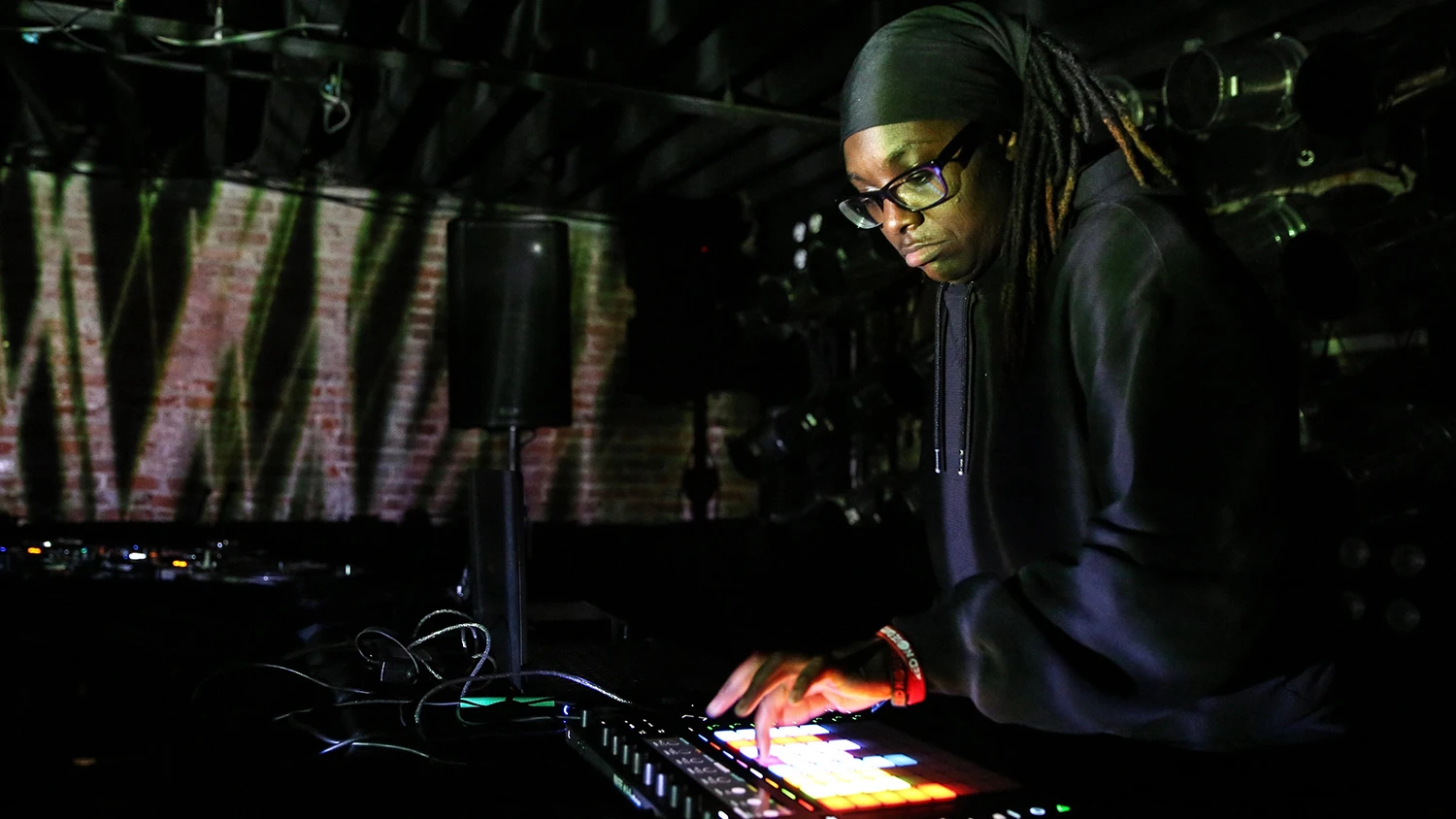
The effects of that phenomenon sting Seattle’s economy. When musical talent and business goes elsewhere, the local ecosystem reaps none of the rewards that would exist if they had stayed. Seattle is “a really great place for the music,” says Ayron Jones, leader of his own rock band. “But because of a lack of resources—I call it the Seattle cycle—it’s hard to get out” and be noticed by a larger audience.
“We’re the city of music,” he adds. “We push that as the forefront of our cultural heritage. We have a beautiful music community here. But not necessarily the strongest business sector or a business economy. You hear about the ‘business centers of music’–L.A., New York, Atlanta, London,” he says, noting that he sometimes gets asked, “‘why don’t you go somewhere else to make this your career?'”
“I think that’s scary,” says Andrew Joslyn, a Seattle-native composer and violinist. “I think it’s scary that we’re losing really good artists to other communities. I think the great thing about the summit and this festival is we’re really finally trying to take a stand and show the world, ‘hey, we’re really trying to be taken seriously as a music center.’ Actually emphasizing that.”
“In the near future, Seattle will be seen as the best scene in the world,” Vetting prophesizes. “And in my eyes it already is. I hope we get that recognition nationally.”
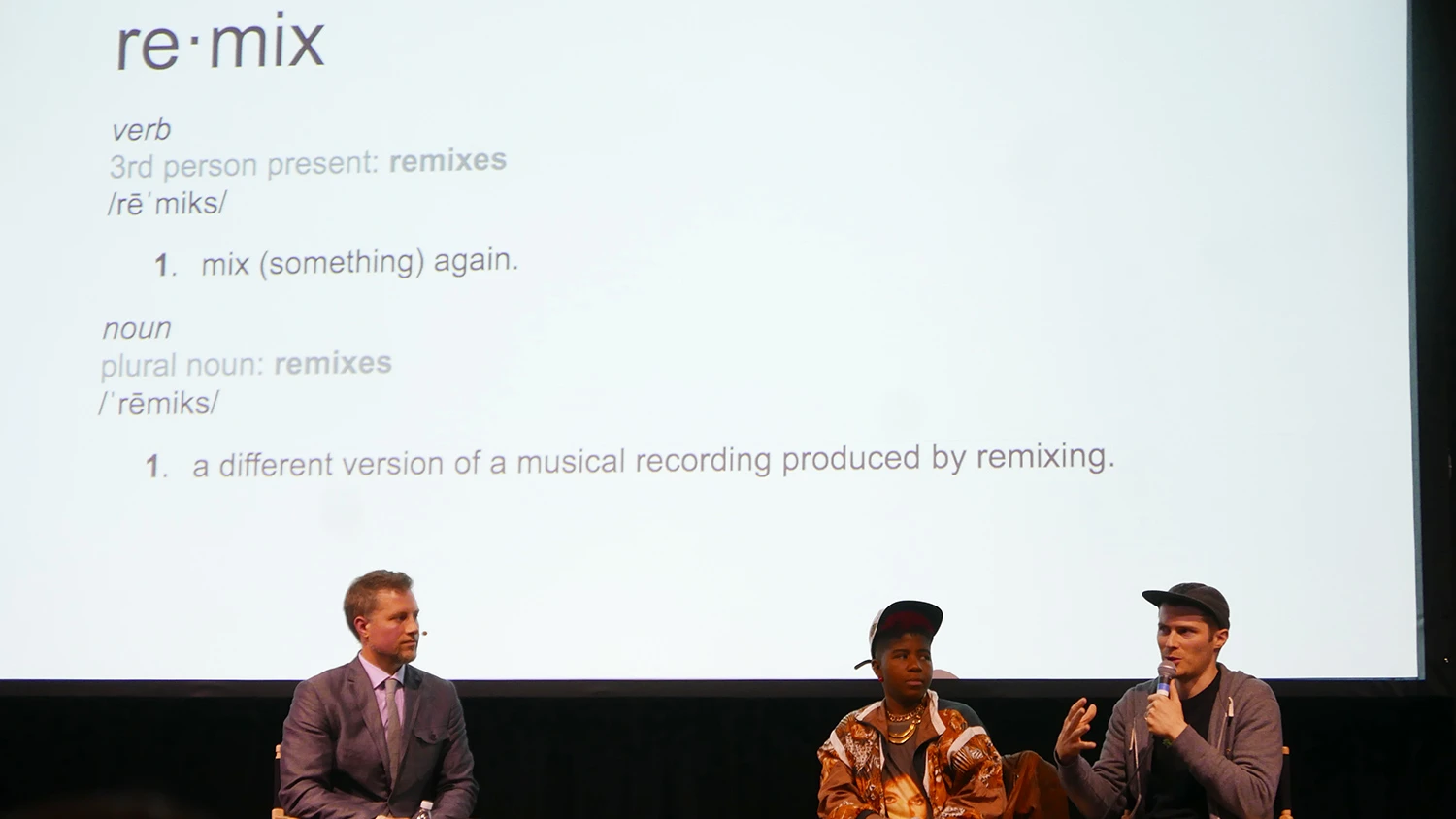
Another sign of how much has changed since the angsty days of grunge: Pavitt is now an app entrepreneur. He is the cofounder and creative director of 8Stem, a tool that allows fans and budding DJs to make remixes of their songs. For Pavitt, Upstream was a chance to see bands–but, just as importantly, he was there “to network and educate both scenesters and baller tech nerds” about his startup.
Will Upstream Happen To Seattle Or With Seattle?
Upstream connects with Paul Allen’s vision of business and philanthropy: experimental, data-driven, and hopefully sustainable. Allen is building the world’s largest airplane to send rockets to space, invests heavily in AI through his Allen Institute for Artificial Intelligence, and is hard at work on a nuclear fusion project via a secretive startup. He has committed $100 million to scientific endeavors at the “frontiers of bioscience.” In 2014 he joined a lawsuit to force the Interior Department to better account for the environmental impact of coal mining on public lands.
Among its “Arts and Culture” portfolio, Vulcan touts the stunning Frank Gehry-designed Experience Music Project (recently rebranded as the Museum Of Pop), founded with about $6 million of Allen’s money, as well as the Living Computers museum, the Flying Heritage Collection, and the Seattle Art Fair–the third installment of which is taking place this weekend to strong reviews.
These aren’t philanthropic projects in the traditional sense. They’re meant to be sustainable businesses, with follow-on effects for the region and its economy. But while Upstream’s publicist offers a pile of metrics (30,000 attendees, more than 70% of whom downloaded the app), he would not disclose any details about the festival’s finances, including how much it cost, what Allen spent, and how close it came to making a profit.
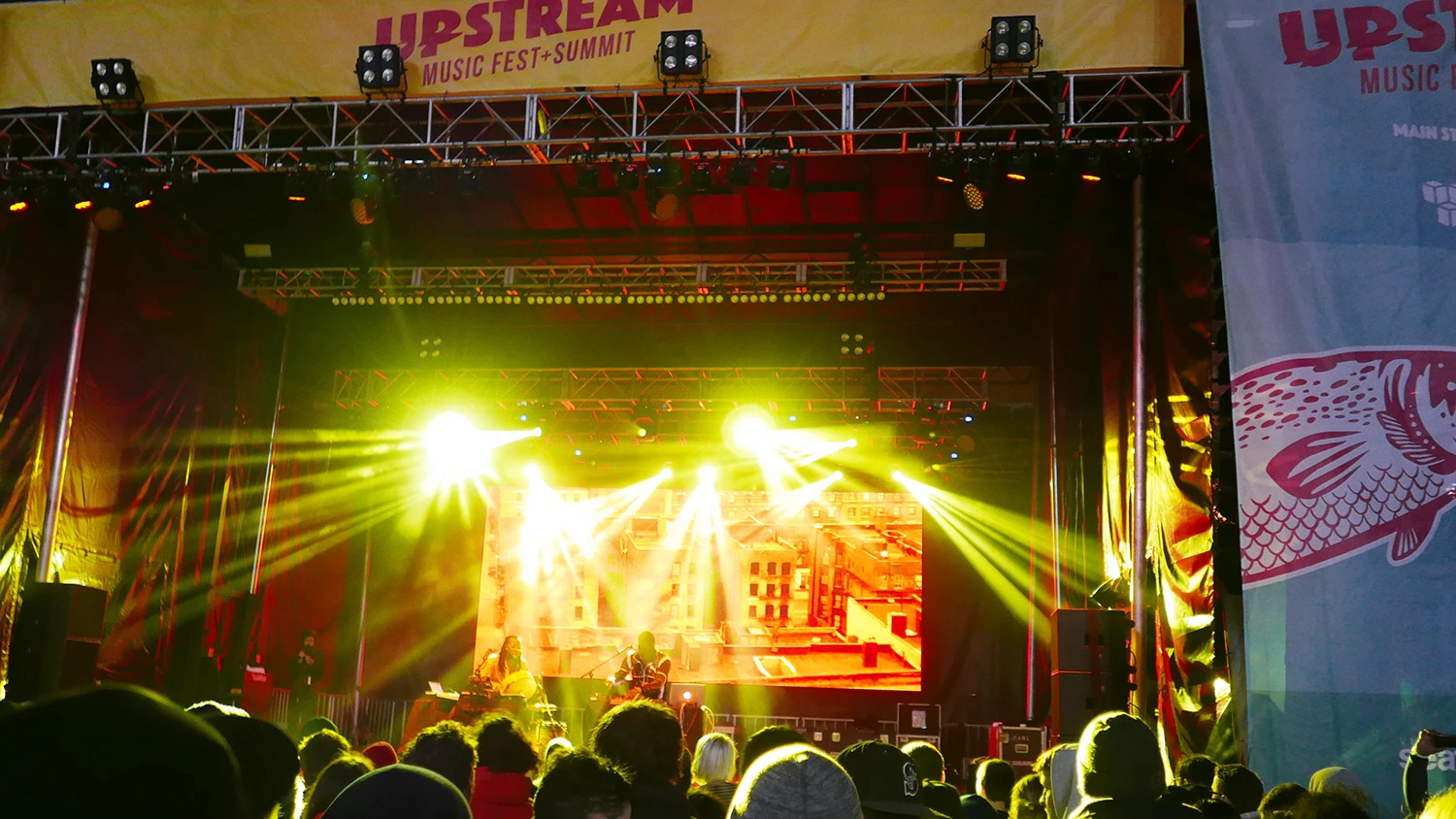
“It’s challenging to launch the first year of any festival—let alone a festival of the size, scale, and ambition of Upstream,” says Vetting. “There was a good deal of learning and problem-solving along the way that I wouldn’t trade.”
Upstream’s urban setting—crucial to its identity and its multidisciplinary format—may work to its advantage. While long-running American camp-out festivals like Sasquatch and Bonnaroo saw their attendance numbers dip significantly last year, city festivals like Montreal’s Osheaga, Toronto’s Field Trip, and Governors Ball in New York are finding more success, according to some observers. Urban festivals benefit from a potential customer base that already lives in the area. Because these audiences can skew slightly older, they are likely to have more disposable income.
Of course, not all of Allen’s art projects have panned out. Famously, Allen stopped funding a handful of Seattle arts groups just a few months before he launched the Seattle Art Fair. Then there was “The Commons,” a failed effort to create a massive public arts space near Lake Union.
Those failures don’t negate the contributions Allen has made to the region. “Perhaps no one has done more for Northwest arts than Allen,” Jen Graves wrote in The Stranger in 2015. “A look at the tax records of his foundation is a tour of the greatest hits of Northwest art and culture of the last 20 years.”
But regardless of the resources that Upstream can provide for local artists, fostering collaboration between the music and business communities—and maybe a detente between the arts scene and the fast-moving economy—is a separate challenge, acknowledges Vetting.
“A big topic that came up time and time again is how Seattle can retain its position as a city that along with all of the business development remains supportive of local artists,” Vetting says. “Seattle is going to continue to thrive, and we recognize that there are complex issues that come with that development, which require many voices and resources at the table.”
Among those voices is a rapper and poet named Geneiva Arunga, who performs as Dadabassed and hails from the Central District, where Vulcan is developing housing and retail projects. “If the singers, DJs, writers, rappers, and artists cannot live in this city, this city will no longer have anything to do,” she told the Seattle Weekly in May. “You can’t just push us out of Seattle and then call us up when you need Upstream and need us to participate in this local showcase. It’s like, hold up—a lot of these artists don’t live here anymore.”
Still, if Allen’s fortunes can help stem some of the side effects of the city’s boom, and if he provides time and space to building community, it seems that many local musicians and activists are willing to work with him rather than against him.
“In Seattle, there’s so much wealth, and I feel like there should be more of a push to help foster creativity,” Madeline Franks, an electronic musician who performs under the name Lilac, told another Seattle Weekly reporter recently. “It doesn’t really feel like that right now, but I don’t want to give up on it.”
Version 1.0 of Upstream was a good reason for more of that optimism, a basic template for what a(nother) new festival might actually add to a city like Seattle. It’s an open question as to whether Allen, Vetting, and the rest of Vulcan can get Upstream to live up to its lofty ambitions. Like a local artist or business, a festival is more interesting and more resilient when it doesn’t just happen to a city, but becomes a part of it.
Recognize your brand's excellence by applying to this year's Brands That Matters Awards before the early-rate deadline, May 3.

